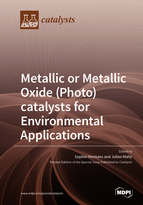Metallic or Metallic Oxide (Photo)catalysts for Environmental Applications
A special issue of Catalysts (ISSN 2073-4344). This special issue belongs to the section "Environmental Catalysis".
Deadline for manuscript submissions: closed (31 August 2021) | Viewed by 29881
Special Issue Editors
Interests: carbon-supported catalysts; biomass valorization; carbohydrate transformations; (nano-)carbon functionalization; nanoparticles synthesis; nanomaterials chemistry
Special Issues, Collections and Topics in MDPI journals
Interests: Heterogeneous photocatalysis, sol-gel process, thin inorganic films, SiO2, TiO2, water and air treatment
Special Issues, Collections and Topics in MDPI journals
Special Issue Information
Dear Colleagues,
Over the last century, industrialization intensified in most countries around the world, and in various fields, particularly the chemical, pharmaceutical, cosmetics, horticulture, food, and petroleum industries. This intense industrialization has resulted in the emergence of a large variety of organic pollutants such as dyes, aromatics, pesticides, solvents, EDCs (Endocrine Disrupting Chemicals) and PPCPs (Pharmaceuticals and Personal Care Products) and the production of various waste such as wood or forest residues, waste from food crops (wheat straw, bagasse), horticulture (yard waste), or human waste from sewage plants. All this pollution and waste need to be treated and valorized in order to maintain a safe and clean environment.
Numerous innovative catalytic and photocatalytic processes are being developed to transform these by-products of our industries into useful compounds. Given the complex nature of these persistent organic pollutants or biomass starting materials, sophisticated catalytic solids need to be elaborated, presenting for example acid/redox bi-functionality or resistance to hydrolysis. This has been the drive for intense research on advanced catalysts preparative methods. Nano-structuration in particular has been a door-opener in this field of application.
In this special issue entitled “methods for metallic or metallic oxide (photo)catalysts for Environmental Applications”, we welcome all kind of papers (research papers, reviews or communications) dealing with (photo)catalytic aiming at environmental applications, based on metallic or metallic oxide materials. The paper can concern either the (photo)catalytic transformation of various waste/biomass to produce higher-value chemicals, or the (photo)catalytic degradation of pollutants, with a strong emphasis on innovative preparation methods.
Prof. Dr. Sophie Hermans
Dr. Julien Mahy
Guest Editors
Manuscript Submission Information
Manuscripts should be submitted online at www.mdpi.com by registering and logging in to this website. Once you are registered, click here to go to the submission form. Manuscripts can be submitted until the deadline. All submissions that pass pre-check are peer-reviewed. Accepted papers will be published continuously in the journal (as soon as accepted) and will be listed together on the special issue website. Research articles, review articles as well as short communications are invited. For planned papers, a title and short abstract (about 100 words) can be sent to the Editorial Office for announcement on this website.
Submitted manuscripts should not have been published previously, nor be under consideration for publication elsewhere (except conference proceedings papers). All manuscripts are thoroughly refereed through a single-blind peer-review process. A guide for authors and other relevant information for submission of manuscripts is available on the Instructions for Authors page. Catalysts is an international peer-reviewed open access monthly journal published by MDPI.
Please visit the Instructions for Authors page before submitting a manuscript. The Article Processing Charge (APC) for publication in this open access journal is 2700 CHF (Swiss Francs). Submitted papers should be well formatted and use good English. Authors may use MDPI's English editing service prior to publication or during author revisions.
Keywords
- Synthesis of catalysts
- Metallic or metallic oxide nanoparticles
- Supported and unsupported catalysts
- Photocatalysis
- Biomass valorization
- Water and air treatment
- Waste treatment







